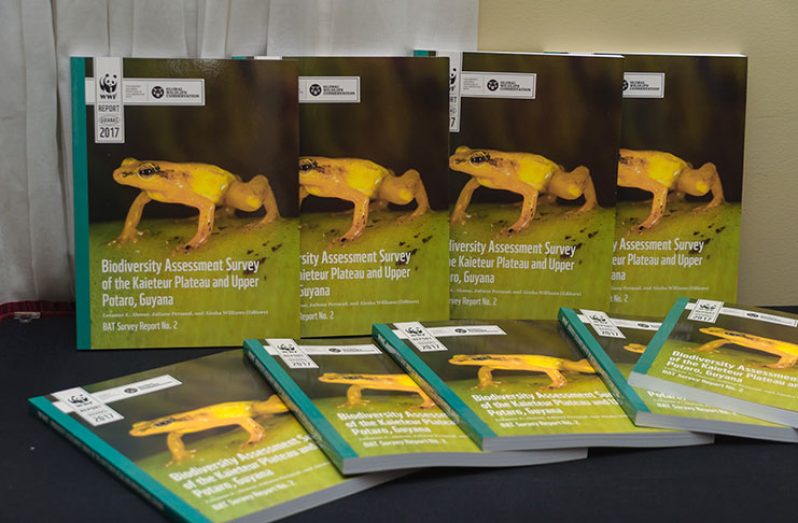–with recent discovery of another 30 species of flora, fauna
THE hidden secrets of Guyana’s rich biodiversity continue to unfold, with the most recent being the discovery of 30 species that are possibly new to science.
Guyana already boasts an estimated 8,000 species of plants, and another 1,800 species of amphibians, birds and mammals according to Guyana’s Fourth National Report to the Convention on Biological Diversity in 2010.

Through the Biodiversity Assessment Survey (BATS), local and international scientists were able to identify the 30 new species that will add to the lot.
The second report on BATS was launched on Thursday evening at the Cara Lodge, where World Wildlife Fund (WWF) Country Manager, Ms Aiesha Williams announced the discovery, which includes six species of fish, three plants, and 15 aquatic beetles among other wildlife.
Although she confirmed that research is still ongoing to determine whether or not the species are new to science, Williams emphasised the importance of protecting the Kaieteur National Park (KNP) where they were found, because there could very well be even more unknown species to be found there.
“The team of scientists surveyed the ‘Kaieteur Top’ and other locations in the Park, as well as the Upper Potaro area,” she said, adding:
“This area has enormous conservation value.”
The study, which was conducted in 2014, targetted freshwater and forest ecosystems which are up to 750 meters above sea level.
It was conducted by scientists and researchers who went from the Kaieteur Falls to Mount Ayanganna and the Pakarima Highlands to collect information on terrestrial, freshwater and taxonomic groups.
Some of the species that were found in that area may not only be new to science, but also recorded for the first time in Guyana’s history.
299 HIGH SPECIES ENDEMISM
She advised those researchers in the audience that the areas that were surveyed have a striking feature of high species endemism, with animals that are unique to the Guiana Shield and Guyana’s high and lowlands.
The area at reference was classified as not just a hotspot for biodiversity, but also a place that has tremendous value for local Indigenous communities, according to researchers.
Persons were advised by Williams to exercise caution at all times, especially when exploiting natural resources, so as to preserve the rich nature of the area.
“Act wisely and use the space in a sensible, well-planned and sustainable manner that maintains the beauty of the vibrant landscape,” she said.
The message was particularly aimed at scientists and members of the private sector who utilise the area for its resources.
They were encouraged to use the report to make informed decisions about the good use of land, freshwater and the natural resources.
Williams reiterated the importance of the habitat for more than 50 per cent of birds, 40 per cent odonates, 30 per cent mammals and 43 per cent amphibians, as well as the more known species such as the jaguar.
Head of the Protected Areas Commission (PAC), Ms Denise Fraser expressed similar sentiments, saying that it is important to manage, maintain and expand the national Protected Areas System.
Since its establishment, PAC has been managing those areas more effectively by developing a management plan for each of the protected areas.
Part of their thrust, however, involves research and information, Fraser said, adding that it helps them to form, guide and probe how they manage the areas.
OLDEST PROTECTED AREAS
The KNP is reportedly one of Guyana’s oldest protected areas, which she said is special for the famous Kaieteur Falls, and important for its diversity for animals and plants that are endemic to that area.
“The population needs to appreciate the beauty of the hinterland and the value of the biodiversity,” Fraser said.
“I believe the report will let them benefit from the information,” she added.
The first report of the survey was launched in March this year. The first publication, “Biodiversity Assessment Team (BAT) Survey of the South Rupununi Savannah, Guyana” represented broad-based documentation of floral and faunal diversity in Guyana’s southern Rupununi region and is based on work undertaken in the Kusad Mountain and Parabara area.
According to the first report, the team also assessed the water quality of the area’s wetlands, creeks and lakes, and natural resource use by local indigenous Wai-Wai and Wapishana communities (Potarinau, Sawariwau, Karaudanawa, Parabara and Shulinab).
The report highlighted some of the most striking characteristics of the South Rupununi savannah region, especially focusing on its diversity of habitats, reflected in the high species-richness and ecological diversity of the flora and fauna.
More than 28 species: 12 species of fish, one bat, 15 aquatic beetles and between 10-25 per cent of ant species were deemed as new to science back then.
Many additional species were recorded for the first time in Guyana and the South Rupununi, and more are expected to be revealed when the third report is launched shortly.




.png)









